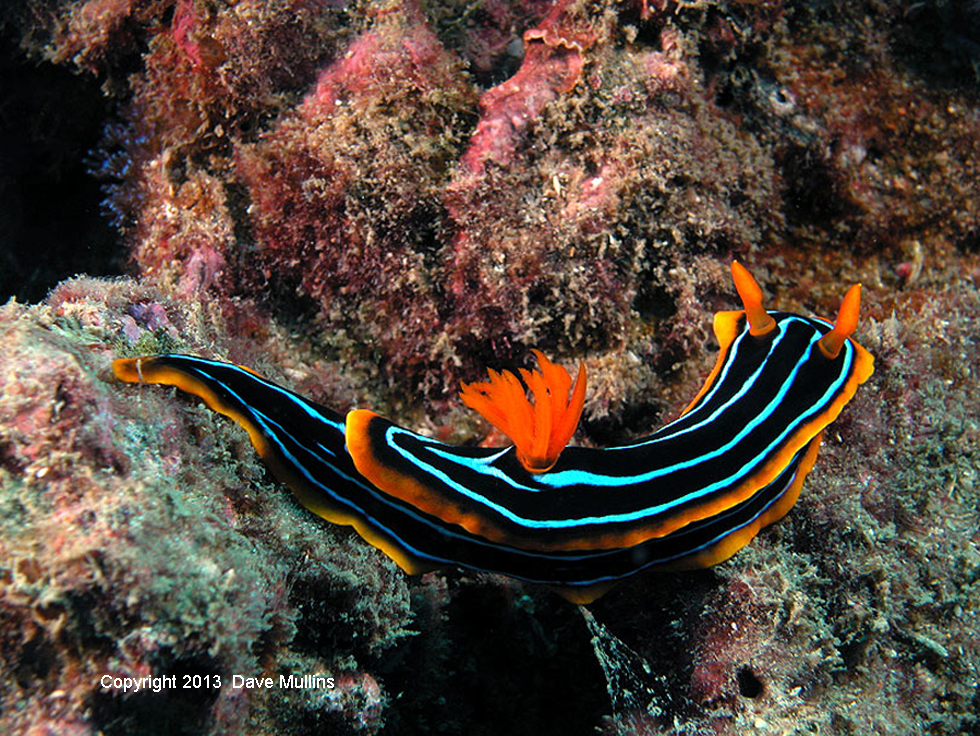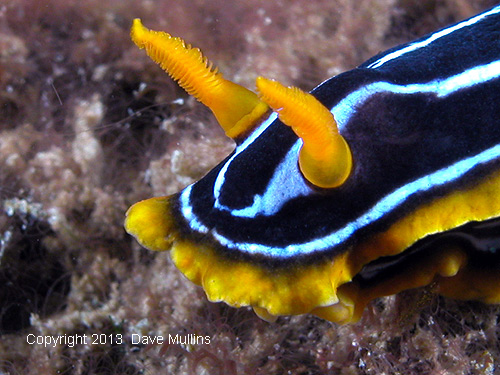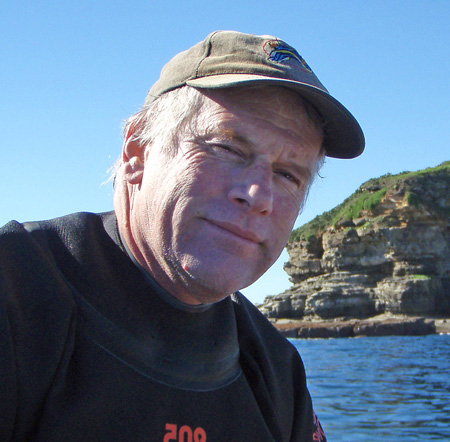 |
Chromodoris kuiteri
Image courtesy of David MullinsOld Woman Island, S.E. Queensland, Australia.
Nikon Coolpix 5000 in Subal Housing, twin Inon Z220 strobes
Chromodoris kuiteri Rudman, 1982
 |
Chromodoris kuiteri Rudman, 1982
Chromodoris kuiteri is a large species and one of a group of similarly coloured and patterned nudibranchs. The primary mantle colour is black. There are four white or very pale blue longitudinal lines. These are narrow and most usually form an inner and outer loop. The innermost loop passes from forward of and between the rhinophores posteriorly to encircle the gills and then continues as a single line. The outer loop runs sub-marginally around the whole mantle. Both loops are contained entirely within the basal black colour. These lines are usually continuous but may be broken or even overlapping. The mantle margin carries a wide orange band and the border between black and orange is not distinct but is instead rather diffuse. The colours and pattern upon the foot are much similar. The lamellate rhinophores and large gills are also orange but can sometimes be of a darker (richer) shade compared to the mantle margin. Chromodoris kuiteri feeds upon Dysidea species of sponge.
|
We normally sight this species in the 50 to 70 mm range but we have recorded one large specimen at 120 mm in length. It is common at certain sites in our survey area.
It is sometimes confused with the similar looking Chromodoris magnifica (which has no black diffusing into the orange and possesses a narrow white marginal band), Chromodoris africana (no black diffusing into the orange marginal band) and Chromodoris quadricolor (no black diffusing into the orange, a very thin white marginal band and the black appears to be arranged into three broad bands). These last two species have an East African, Red Sea and Western Indian Ocean distribution. The first impression received on sighting Chromodoris kuiteri is that of a predominately black species and that, combined with the diffusion of the black into the orange margin usually helps to settle any confusion.
Distribution is limited to the coastal waters and offshore reefs of Queensland and New South Wales, Eastern Australia and also Lord Howe Island. We are not entirely convinced that a few reports from Western Australia represent this species.
References:
Rudman 1998 - 2010. Chromodoris kuiteri, Factsheet & Related Messages, Sea Slug Forum, Australian Museum, Sydney.
Marshall & Willan 1999. Nudibranchs of Heron Island, Great Barrier Reef, Backhuys Publishers.
Wilson N. 2002. Egg Masses of Chromodorid Nudibranchs, Malacologia, 2002,44(2): 289-305.
Rudman & Bergquist 2007. A review of feeding specificity in the sponge-feeding Chromodorididae, Molluscan Research 27(2): 60-88
Yonow N. 2008. Sea Slugs of the Red Sea, Pensoft Publishers, Bulgaria.
Queensland, Australia
Send Dave email at marineimages@hotmail.com
Sept. 2013
David Mullins
 |
Dave Mullins has been taking underwater photos since 1970 and seen and embraced a host of changes and developments in diving and underwater photographic equipment and practices since then. He dived the Great Barrier Reef, Australia for many many years however for the past ten years he has focused his efforts almost entirely upon the Sunshine Coast, Queensland, Australia documenting the sea slugs of the region. To adequately survey the area he operates both a 5 metre RIB on the Sunshine Coast and a 10 metre powercat out of Scarborough on Moreton Bay. Together with Gary Cobb he has found 550 species of sea slug in this area alone that have been recorded and posted on their website:
nudibranch.com.au He has retired from his engineering business and recently taken on the CRITTER ID column in SportDiving Magazine (formerly by the late & great Neville Coleman) with the assistance of several world-renowned experts. Visit his website: www.marineimages.info and use the CRITTER ID Portal there to have your critters identified or confirmed and published in the magazine. |
